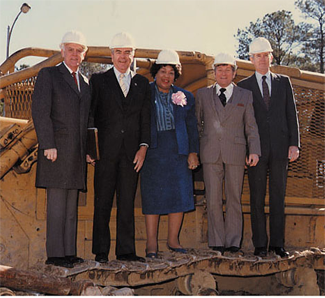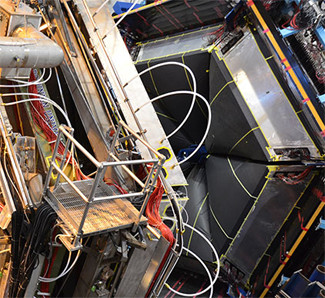History


Timeline of Jefferson Lab
2020 On Nov. 20, Jefferson Lab shipped the 21st and final cryomodule that it built for the Linac Coherent Light Source II Upgrade project at SLAC National Accelerator Laboratory in Menlo Park, Ca.
2020 The “Yellow Report” containing goals for the Electron-Ion Collider project were published on March 8
2019 Jefferson Lab joined Brookhaven National Lab to mark launch of the Electron-Ion Collider project in September
2019 Commonwealth of Virginia and Science Museum of Virginia named Volker Burkert the Outstanding Scientist of the Year on September 26
2019 In April, Hall D scientists announced that CEBAF has produced its first charm quarks for study in J/ψ (J/psi) particles in Hall D. Prior to this, only particles made of up, down and strange quarks had been produced
2018 The 12 GeV CEBAF Upgrade project was ceremonially dedicated on May 2
2018 Jefferson Lab received a Department of Energy Project Management Achievement Award, for the Office of Science’s 12 GeV Continuous Electron Beam Accelerator Facility Upgrade Project in March
2018 CEBAF delivered electron beams simultaneously to all four experimental halls, including its newly completed Hall D, for the first time on Jan. 12
2017 Kevin Jordan, a staff engineer in Jefferson Lab’s Center for the Advanced Studies of Accelerators, received NASA Invention of the Year award in December
2017 CEBAF began operations following completion of the 12 GeV CEBAF Upgrade project in December
2017 The CEBAF 12 GeV Upgrade Project is completed on Sept. 27
2017 The first experimental result from the 12 GeV upgraded CEBAF is published in May
2017 Stuart Henderson appointed Jefferson Lab director, assumes office on April 3
2016 Jefferson Lab became an Intel® Parallel Computing Center in September
2017 Jefferson Lab received the Perfect Record Award and Occupational Excellence Achievement Award, from the National Safety Council in May
2015 CEBAF delivered the first full-energy 12 GeV electrons (12.065 GeV) on December 14
2014 CEBAF delivered its highest-energy beams ever, 10.5 billion electron-volts (10.5 GeV) through the entire accelerator and up to the start of the beamline for its newest experimental complex, Hall D, on May 7
2013 Jefferson Lab became a key contributor to the LCLS-II project to upgrade the Linac Coherent Light Source at SLAC National Accelerator Laboratory in Menlo Park, Ca. The LCLS-II project is being developed and built for SLAC by a collaboration that includes Jefferson Lab, Argonne National Lab, Berkeley Lab, Fermilab and Cornell University. Jefferson Lab contributed 21 cryomodules, design and purchase of the cryogenics plant, and the RF control system
2013 10 new cryomodules built for 12 GeV Upgrade are officially named on March 12
2012 Technology and Engineering Development Building Earns LEED Gold Rating
2012 Dirk Walecka, Jefferson Lab’s first Scientific Director, is appointed its first Scientist Emeritus on November 12
2012 CEBAF ceases 6 GeV operations for 12 GeV Upgrade installation on May 18; 178 experiments were completed with original CEBAF
2012 A 12 GeV cryomodule demonstrates full design energy, imparting 108 Megavolts of power to the electron beam over a planned hour of stable running at full specification on May 18
2012 Technology and Engineering Development Building opens
2011 Publication of “New Insights Into the Structure of Matter: The First Decade of Science at Jefferson Lab” on June 8
2011 Free-Electron Laser delivers first beams of Vacuum Ultraviolet light into a lab for experiments on February 28
2011 Free-Electron Laser injector demonstrates record-setting, stable 500 kilovolt operation on February 18
2011 Cynthia Keppel, a Hampton University professor, staff scientist at Jefferson Lab, and scientific and technical director of the Hampton University Proton Therapy Institute is named a Virginia Outstanding Scientist on Jan. 27
2010 Jefferson Lab supercomputer tops 100 Teraflops in processing power
2010 Free-Electron Laser delivers first ultraviolet beams through new beamline on August 31
2010 Construction begins on Technology and Engineering Development Facility
2009 Site Clearing begins for Hall D construction
2009 Construction begins on 12 GeV Upgrade
2009 All three halls ran polarized experimental targets (target particles spin in unison) while also receiving polarized beam for the first time on February 4
2008 12 GeV Upgrade receives CD-3 approval from the Department of Energy, clearing the way for construction to begin on the $310 million project September 15
2008 Hugh E. Montgomery appointed Jefferson Lab director, assumes office on September 2
2007 Cryogenics Group wins prestigious White House Award for major energy-saving advancements June 12
2007 12 GeV Upgrade Project receives Critical Decision-2 approval from the Department of Energy, authorizing the final design phase to begin and allowing a request for the project’s construction funding to be included in a federal budget.
2007 Upgrade Free-Electron Laser surpasses 10 kW design to achieve 14.2 kW in the infrared on Oct. 30
2006 Jefferson Science Associates, LLC, signs contract to manage Jefferson Lab (April 14); new contract effective April 17
2006 12 GeV Upgrade Project receives Critical Decision-1 approval from the Department of Energy, allowing for project engineering and design efforts to begin
2006 Occupancy begins upon completion of CEBAF Center addition in January
2006 Dilon Technologies sells first breast-specific gamma imaging production unit to a clinic in Las Vegas; the Dilon 6800 Gamma Camera has proven to be an effective tool in the early detection of breast cancer and in the differentiation of malignant and benign tumors
2005 Free-Electron Laser earns R&D 100 Award
2005 Jefferson Lab delivers final cryomodule for the Spallation Neutron Source at Oak Ridge National Lab
2005 Jefferson Lab produces first single-crystal niobium accelerating cavity prototype in a proposed design for the planned International Linear Collider (ILC)
2005 A positron emission mammography unit designed and built by Jefferson Lab scientists proves capable of distinguishing small breast tumors
2004 Free-Electron Laser achieves 10 kilowatts (Infrared) July 21
2004 Construction begins on the CEBAF Center Addition, which creates 60,000 square feet of office space
2004 Jefferson Lab scientists complete 100th experiment with CEBAF in March
2004 Jefferson Lab’s 12 GeV Upgrade achieves Critical Decision-Zero (CD-0), a DOE designation that recognizes the “mission need” for the Upgrade and allows the lab to develop conceptual, acquisition and project execution plans(April 19)
2004 Anatoly Rayushkin, a jointly appointed physics professor at Old Dominion University and senior scientist at Jefferson Lab, is named a Virginia Outstanding Scientist
2003 DOE’s 20-year facility plan names Jefferson Lab’s 12 GeV Upgrade one of the 12 near-term priorities
2003 Jefferson Lab conducts a novel experiment with the Continuous Electron Beam Accelerator to determine the feasibility and effectiveness of energy-recovery technology, which could lead to the development of a new class of particle accelerators
2003 Dirk Walecka, College of William & Mary physics professor and former scientific director of CEBAF, is named Virginia’s Life Achievement in Science recipient
2002 The Spallation Neutron Source in Oak Ridge receives the first Jefferson Lab designed and built cryomodule
2001 Jefferson Lab FEL terahertz radiation experiment generates levels 20,000 times brighter than anyone else; November 2002 issue of Nature subsequently publishes results
2001 SURA names Christoph W. Leemann as Jefferson Lab’s new director
2001 Construction begins for the upgrade of the Free-Electron Laser to reach 10 kilowatts infrared and one kilowatt of ultraviolet light
2001 Infrared Demo Free-Electron Laser achieves top output of 2.1 kW on July 12, more than double the original design goal
2001 Pre-conceptual design report published on project to upgrade the energy of the CEBAF accelerator to 12 GeV and to build a fourth experimental hall
2000 Jefferson Lab receives the contract to engineer and assemble the superconducting accelerator, and to design and oversee installation of the helium refrigeration plant for the Spallation Neutron Source (SNS) for the Oak Ridge National Lab
2000 CEBAF reaches enhanced design energy of 6.07 GeV (August 6)
1999 Installation of second polarized electron gun boosts physics program
1999 Infrared Demo Free-Electron Laser surpasses 1 kW design goal to achieve 1.72 kW on July 15
1998 Commonwealth of Virginia and Science Museum of Virginia name JLab Director Hermann A. Grunder the Outstanding Scientist of the Year
1998 Five-pass, 4 GeV, three-beam separation to all three experimental halls on June 19
1998 Free-Electron Laser achieves first light at 155 watts – 28 times the existing power record – on June 17
1997 Hall B begins taking data with the CEBAF Large Acceptance Spectrometer
1997 First polarized electron beam used for experiment in Hall A – 30 microamps at 35 percent polarization
1997 Vice President Al Gore awards the Directives Review Team the Vice President’s Hammer Award for the simplification of the Environment, Health and Safety (EH& S) requirements, a contribution in support of President Clinton’s National Performance Review (NPR)
1997 Hall A begins taking data for its first experiment on May 19
1997 Dilon Technologies licenses Jefferson Lab detector technology for medical imaging for diagnostics and research purposes, including detection of cancers in the breast, thyroid, brain and prostate
1996 Applied Research Center (ARC) breaks ground on May 19
1996 Free-Electron Laser (FEL) construction begins June 11
1996 CEBAF changes name to the Thomas Jefferson National Accelerator Facility (Jefferson Lab) at lab dedication on May 24
1995 First physics experiment begins taking production data in Hall C on November 15: “The Energy Dependence of Nucleon Propagation in Nuclei as Measured in the (e, e’p) Reaction”; Commissioning data began in October
1995 CEBAF, NASA and Digiray Corp. awarded the R&D 100 Award for work on the reverse geometry x-ray miniprobe (RGM). The system is being used to find cracks and corrosion in oil refinery piping
1995 Accelerator reaches design energy of 4 GeV (billion electron volts); May 10, accomplished design energy in pulse mode; May 26, 4 GeV pulses delivered to target in Hall C; November 4, achieves full design goal with a stable, five-pass 100 kW continuous 4 GeV beam delivered to Hall C
1995 First polarized electron beam delivered from polarized gun (February)
1994 First beam is delivered to target on July 24 (Hall C)
1994 First beam is delivered to an experimental hall on July 1 (Hall C), marking the beginning of operations of the first large installation of superconducting radiofrequency technology.
1994 First time liquid helium coolant in CEBAF becomes superfluid, allowing for stable operation of the electron beam. Helium in CEBAF remained superfluid until Hurricane Isabel took the Central Helium Liquefier down in 2001
1993 Workers install Golden Girl, the last cryomodule needed to complete CEBAF (December 23)
1991 CEBAF receives first patent
1991 CEBAF injector, the source of electrons for the accelerator, reaches full design energy on March 30, accelerating an electron beam to 45 MeV
1990 Workers install Gray Ghost II, the first production cryomodule – a modular section of accelerator for CEBAF – in the injector
1988 DOE awards five-year management and operating contract to SURA
1988 First successful tests of a cryounit, a section of accelerator containing two superconducting radiofrequency accelerator cavities, demonstrates feasibility of SRF in CEBAF (January)
1987 Construction begins on Continuous Electron Beam Accelerator Facility (CEBAF) on February 13
1986 U.S. Congress appropriates funds for construction (October)
1985 JLab adopts superconducting electron accelerating technology
1985 Hermann Grunder assumes first directorship in May
1984 Scientists interested in conducting research once the facility is operational form a Users Group
1984 Department of Energy provides initial funding for research, development and design (August 3)

